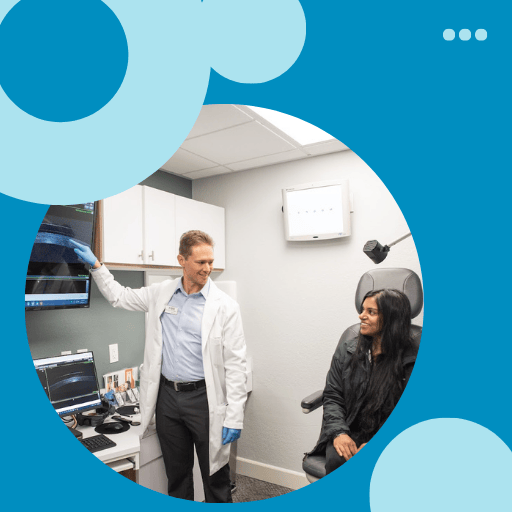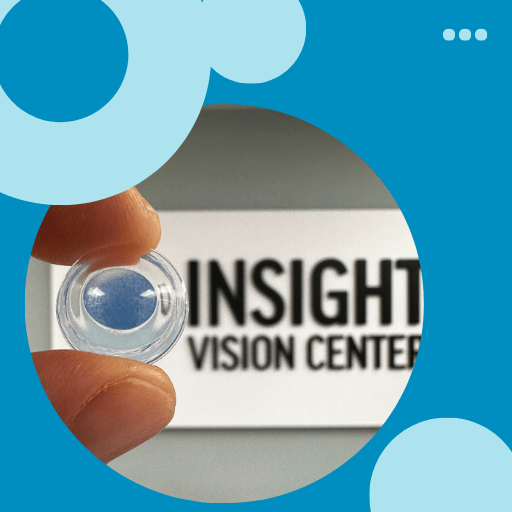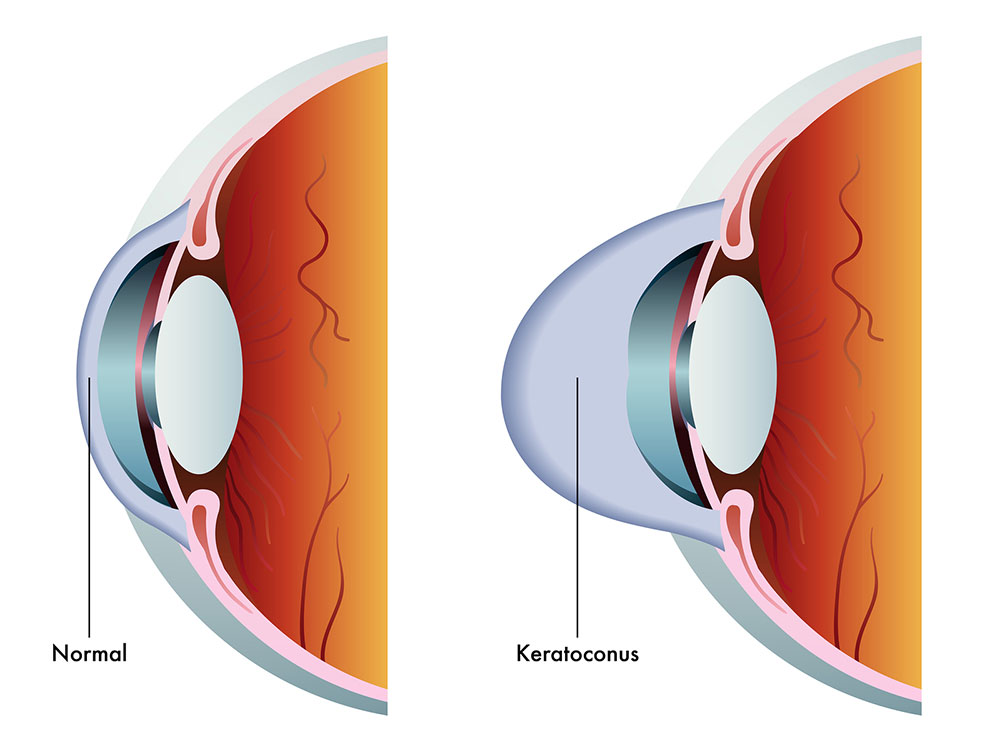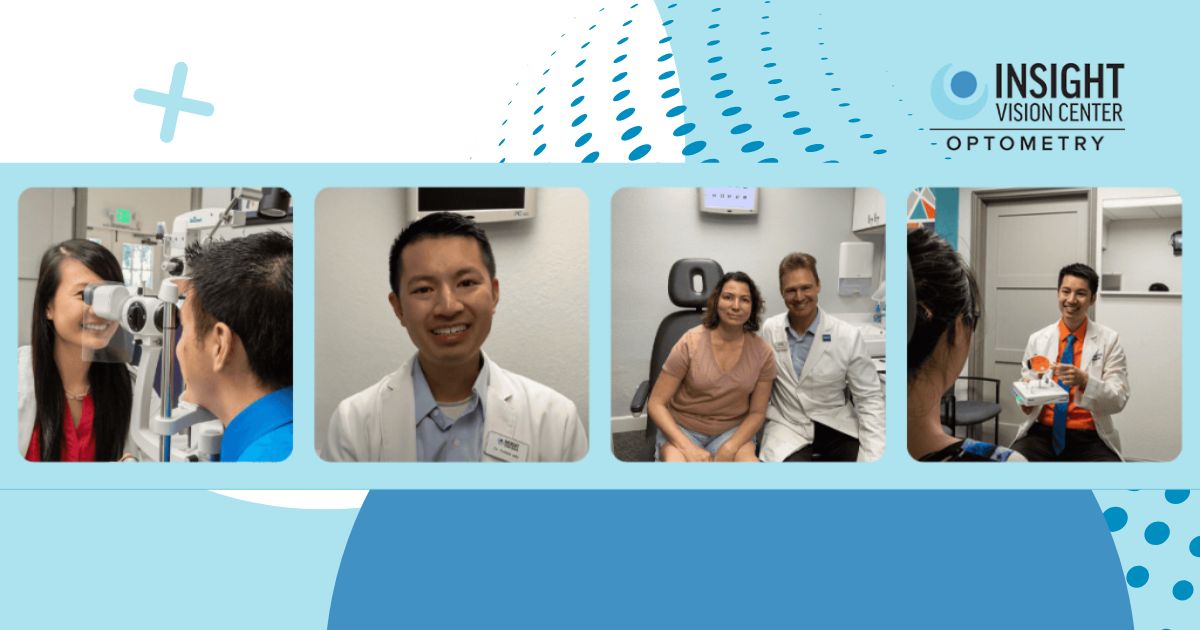Keratoconus Management
- 5 Best Contact Lenses For Keratoconus
- Can I Wear Soft Contact Lenses For Keratoconus?
- Effective Keratoconus Solutions

What is Keratoconus?

Keratoconus is a progressive eye condition that affects the shape and structure of the cornea.
The term “keratoconus” comes from the Greek words “kerato” (cornea) and “conus” (cone).
Prevalence and Demographics
Keratoconus is not a rare condition, but it’s not extremely common either.

While non-surgical management options are often the first line of treatment for keratoconus, there are cases where surgical intervention becomes necessary. As the leading eye doctors in keratoconus care in Orange County, we are well-versed in the latest surgical techniques and emerging treatments.
When is Surgery Considered?

It’s important to note that the decision to pursue surgical treatment is always made on a case-by-case basis with your eye doctor, considering the individual patient’s needs, lifestyle, and overall eye health.
Surgery for keratoconus is typically considered in the following scenarios:

Corneal Collagen Cross-Linking (CXL)
Corneal collagen cross-linking is a minimally invasive procedure that has revolutionized keratoconus treatment by offering a way to halt the progression of the disease.

How CXL Works
The procedure involves applying riboflavin (vitamin B2) drops to the cornea and then exposing it to controlled ultraviolet (UV) light. This process creates new chemical bonds between collagen fibers in the cornea, strengthening and stabilizing it.
Types of CXL
Advantages of CXL
- Halts or slows the progression of keratoconus
- Can prevent the need for corneal transplantation in many cases
- Minimally invasive with a relatively quick recovery time
Considerations
- Best results are typically seen in younger patients with progressive disease
- Vision may continue to fluctuate for several months after the procedure
- Additional vision correction (glasses or contact lenses) is still usually required

Corneal Tissue Addition for Keratoplasty

Corneal Tissue Addition for Keratoplasty (CTAK) represents a cutting-edge development for treating keratoconus, a progressive eye disease that causes thinning and a cone-like protrusion of the cornea. Let’s break it down into simple, relatable terms.
How CTAK Work
CTAK utilizes custom laser-cut tissue inlays tailored specifically for each patient. These inlays are made from acellular corneal stromal tissue, sterilized using gamma irradiation for both safety and stability. The inlays are placed in the cornea to improve its thickness and reshape its contour naturally.
These personalized inlays not only enhance the cornea’s thickness but also create a more uniform and stable corneal shape. This innovative approach is like giving your cornea a perfect-fitting patch, crafted just for its unique curvature and needs.
Advantages of CTAK
CTAK replaces INTAC favoring CTAK because:
Considerations
CTAK isn’t a universal solution for every keratoconic patient. Here are some important points to keep in mind:


Topography-Guided PRK
Topography-guided Photorefractive Keratectomy (PRK) is a laser procedure that can be used to regularize the corneal surface in some cases of keratoconus. Note that this procedure is not yet FDA approved.
How Topography-Guided PRK Works
Using detailed corneal topography maps, the excimer laser ablates the cornea in a precise pattern to reduce irregularities and improve the overall shape.

Deep Anterior Lamellar Keratoplasty (DALK)
DALK is a partial-thickness corneal transplant procedure that replaces the front and middle layers of the cornea while leaving the innermost layer (endothelium) intact.
How DALK Works
Advantages of DALK
Considerations

Penetrating Keratoplasty (PK)
Penetrating Keratoplasty, also known as a full-thickness corneal transplant, involves replacing the entire cornea with donor tissue.
When PK is Considered
- In very advanced cases of keratoconus
- When there’s significant scarring throughout all layers of the cornea
- If DALK is not possible or has failed
Advantages of PK
- Can significantly improve vision in advanced cases
- May be the only option in cases of severe corneal scarring
Considerations
- Higher risk of graft rejection compared to DALK
- Longer recovery period
- Lifelong need for careful monitoring and sometimes long-term steroid use

Bowman Layer Transplantation
This is a relatively new surgical technique for advanced keratoconus that’s not suitable for DALK or PK.
How it Works
The Bowman’s layer from donor corneal tissue is isolated and transplanted into the recipient’s cornea, creating a form of natural corneal inlay.
Advantages
Considerations
Emerging Treatments
The field of keratoconus treatment is constantly evolving, with several promising treatments on the horizon.
Combination Therapies
Increasingly, combination approaches are being used to maximize treatment effectiveness.
Post-Surgical Management
Regardless of the surgical intervention chosen, post-operative care is crucial for optimal outcomes.

Key Aspects of Post-Surgical Care
- Adherence to prescribed medication regimens
- Regular follow-up appointments
- Monitoring for signs of complications
- Gradual return to contact lens wear when appropriate
Visual Rehabilitation
After surgery, patients may need to be refitted with contact lenses or may require updated spectacles. In some cases, Advanced contact lenses like scleral lenses may provide the best visual outcomes even after surgery.
The Importance of Customized Treatment Plans
As keratoconus eye doctors, we understand that every patient’s eyes are unique. What works well for one person may not be the best solution for another. Our approach involves:
Living with Keratoconus
Keratoconus is a chronic condition that can significantly impact a person’s daily life. However, with proper management and support, individuals with keratoconus can lead fulfilling lives and pursue their goals.
Understanding the Emotional Impact
Keratoconus can bring emotional challenges such as anxiety about potential vision loss, future career prospects, and treatment procedures. Many patients experience frustration adapting to fluctuating vision or contact lenses while explaining the condition to others who may not understand. The overwhelming nature of the diagnosis and grieving the loss of “normal” vision can lead to feelings of depression.
To cope, seek support through keratoconus groups or counseling, and educate yourself to reduce anxiety and feel empowered in decision-making. Communicate openly with loved ones and your care team, and prioritize self-care activities to promote overall well-being and stress reduction. With the right strategies, you can navigate the challenges and focus on improving your quality of life.
Adapting to Daily Life
Living with keratoconus often requires some lifestyle adjustments. Here are some strategies for managing daily activities:

Managing Contact Lens Wear
For many keratoconus patients, contact lenses are a crucial part of their vision correction. Here are some tips for successful lens wear:

Our Expertise in Keratoconus Care
At our practice, we pride ourselves on offering state-of-the-art care for patients with keratoconus. Our team of world class eye doctors has extensive experience in managing this complex condition, from early diagnosis through advanced treatment options. We are proud to be the top rated advanced contact lens practice in Orange County, and we are referred for Keratoconus from Santa Ana, Huntington Beach, Irvine, Orange, and across Orange County.
Our Technology
We invest in cutting-edge technology to provide the best possible care for our keratoconus patients:


Frequently Asked Questions
Orange County’s Trusted Eye Doctors in Keratoconus Care
At Insight Vision Center Optometry, we are proud to serve the diverse communities of Orange County, California. Our conveniently located practice in Costa Mesa offers easy access for patients from nearby areas like Newport Beach, Huntington Beach, Irvine, Santa Ana, and beyond.
As Orange County’s leading eye doctors in keratoconus, we’re dedicated to giving you the best possible outcomes. Whether you need advanced contact lenses, non-surgical treatments, or eye doctors advice, our team is here to help you see the world clearly again.
Don’t wait to address your keratoconus. Schedule a consultation with the trusted eye doctors at Insight Vision Center Optometry today. Call (714) 942-1361 to book your appointment. Let us help you achieve better vision and a brighter future!





